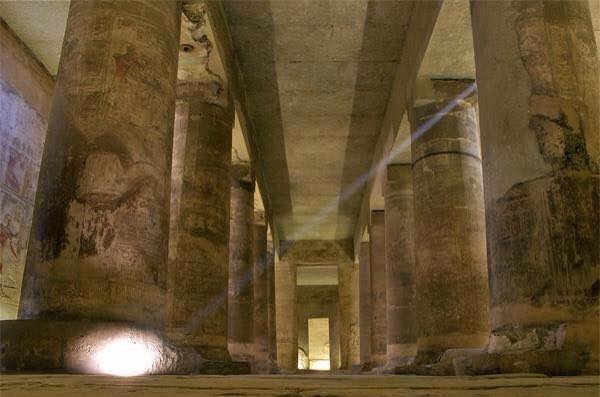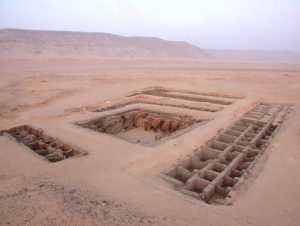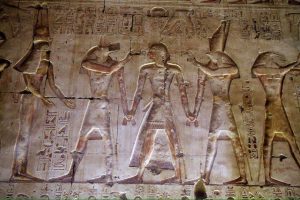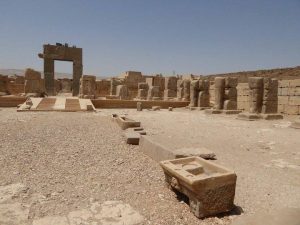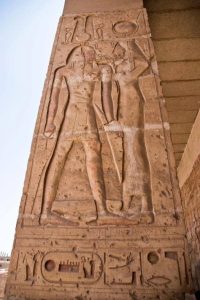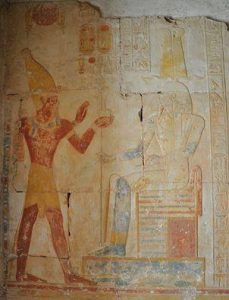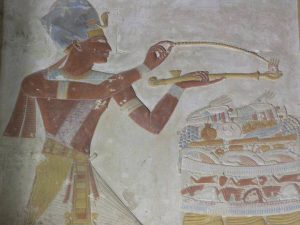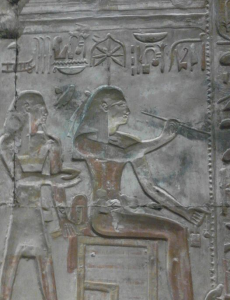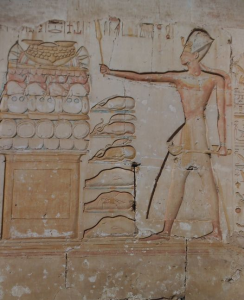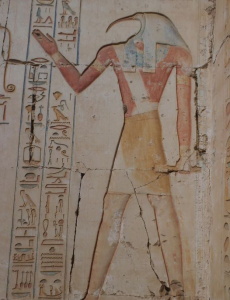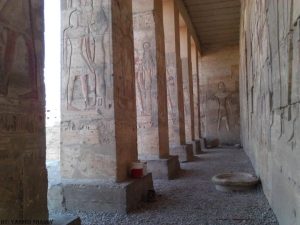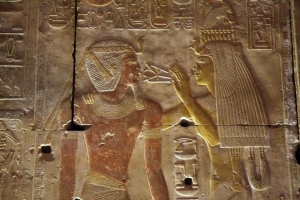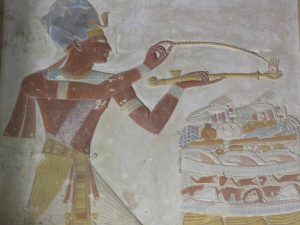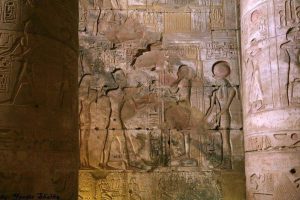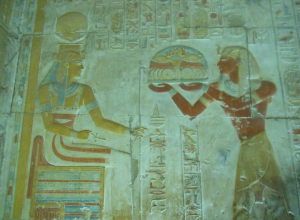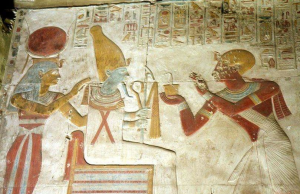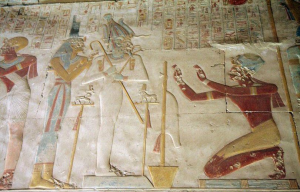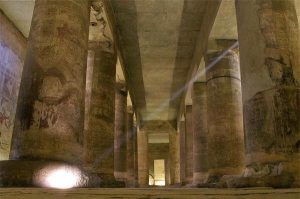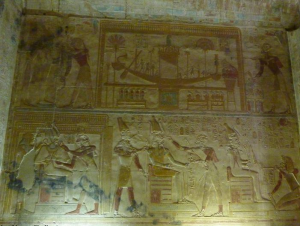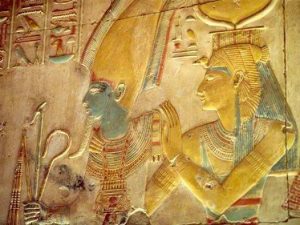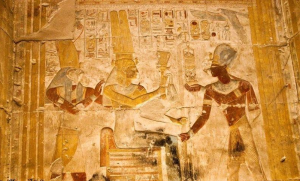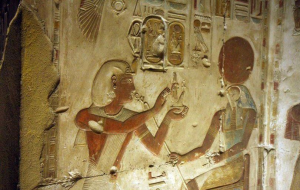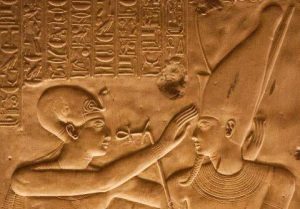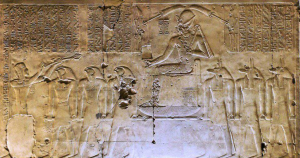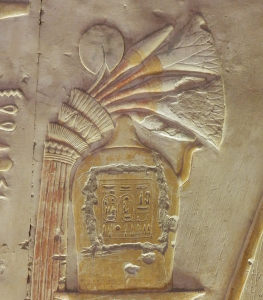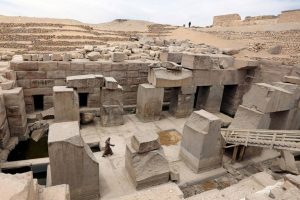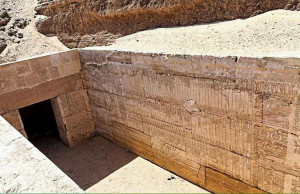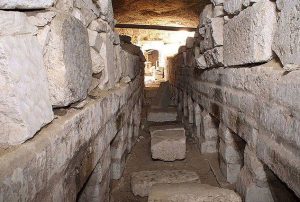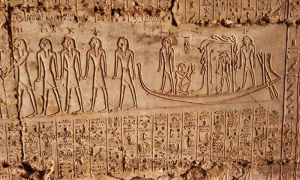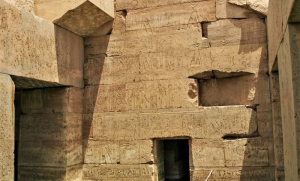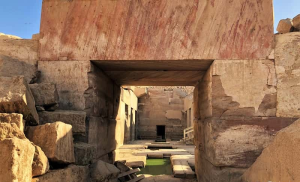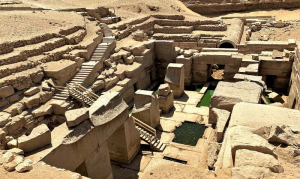Abydos
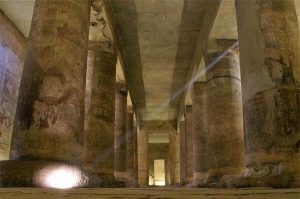
Introduction
The name came from the word “Abidu,” meaning “the hill” on which the head of Osiris was buried, and from which came the Greek word “Abydos.” In the Pharaonic era, it was called “Theni,” and now it is called ” El Araba El Madfuna “This area has been sacred since pre-dynastic times because it is believed in Egyptian mythology that the head of Osiris was found there. Therefore, they built a symbolic tomb for him in this place, and all the kings of Egypt either made pilgrimages to this tomb or built their tombs in that area. In this area, there are tombs of the kings of the first and second dynasties. There is also what is known as the ” shunet el-zebib ” (which was later used as a Coptic monastery). Many buildings were built in the Middle Kingdom, so that King Senusret III himself built a tomb in Abydos. The kings of the New Kingdom were interested in building in this sacred spot, so Seti I built the Osireion (the symbolic tomb of Osiris). He also built his famous temple in Abydos, which is considered the most beautiful temple in Egyptian civilization, and his son, King Ramses II, completed it. In the year 2000, a group of ancient Egyptian boats were found, numbering 14 boats, which indicates that the Egyptians, since the earliest times, used to go to their tombs in Abydos for pilgrimage. These are the oldest Egyptian boats ever found.
A tomb of one of the kings of the Early Dynastic Period (the first and second dynasties), King Djer, in Abydos
The Temple of Seti I (Abydos Temple)
Built by King Seti I and completed by his son, King Ramses II, this temple was dedicated to the god Amun-Ra. It is considered the most beautiful Egyptian temple in terms of its interior carvings, especially in the second hypostyle hall. When the temple was built and due to the existence of the Osireion (a memorial monument for Seti I), the axis of the temple was changed to avoid the Osireion, resulting in a T-shaped plan, which differs from other temples in the existence of seven Egyptian shrines instead of three. The central (largest) shrine was for the god Amun-Ra. On the western side are chambers for the Osirian triad (Osiris, Isis, and Horus). On the eastern side are chambers for the gods Ra-Hor akhty, Ptah, and Seti I himself. King Seti I was the first to carve battle scenes on the outer pylon of his temple in Abydos, and then he carved them in the great hypostyle hall of Karnak. His son Ramses II and all the kings of Egypt after him imitated him in this. The construction of the temple took 20 years
The Goddess Hathor with gods Wepwawet, Upuaut, and Horus, give the ankh (symbol of life) to King Seti I in the Temple of Seti I at Abydos.
Description of the Temple
Entrance:
The temple’s pylon is ruined, and the first courtyard is completely destroyed. Only on its southern wall are there reliefs of Ramses II depicting battle scenes and his victories. At the end of the courtyard, there is a descending corridor leading to the hypostyle hall with square columns. On the columns are famous scenes of the king with various gods.
Second Entrance:
After the columns, there is a surface with three openings, and on its back, the reliefs of Ramses II continue. The second courtyard is also ruined, and the remains of the walls have reliefs of Ramses II. (There were seven openings on the walls corresponding to the seven shrines inside the temple, but Ramses closed all of them except for the central opening.) At the end of the courtyard, there are 12 square columns of limestone with reliefs of Ramses II with the gods. There are also scenes on the entrance depicting Ramses II offering the maat to the god Osiris, the goddess Isis, and to his father, King Seti I. On the western wall, we see Ramses II smiting the enemies in front of the god Amun-Ra. There is also a 95-line inscription in which Ramses describes his completion of his father’s temple here in Abydos.
A ruined courtyard from the Temple of Ramses II in Abydos
A relief of one of the columns of the facade of Seti I’s temple, where Isis embraces King Seti I and gives him the ankh, symbol of life, in his temple at Abydos.
King Ramses II offers the offerings of the Nun to the blue-skinned god Osiris wearing the double crown, in the Temple of Ramses II at Abydos.
The first hypostyle hall
A hall of 24 round columns topped with capitals of the budding papyrus flower. On the back wall of this hall, there are 7 entrances leading to the second hypostyle hall. Therefore, we find scenes on the columns representing King Ramses II in front of the god to whose shrine the corridor leads.
King Ramses II offers sacrifices to the gods, from the wall reliefs of his temple in Abydos
The god Thoth in the form of a human with the head of an ibis, from the reliefs of the Temple of Ramses II at Abydos.
The second hypostyle hall
It consists of thirty-six columns in three rows. The first and second rows have columns in the shape of budding papyrus flowers, while the third row has round columns without capitals, with rectangular pieces on top of each. This hall contains the most beautiful scenes and reliefs that are unmatched by any reliefs in any temple at all.
The most important scenes on the western wall:
• Scenes of King Seti I burning incense and offering holy water to the gods Osiris, Ra-Horakhty.
• Then, the king offering sacrifices in front of a large shrine where the god Osiris sits, with Maat, the goddess of truth and justice, and Renpet, the goddess of harvest, seated in front of him. Behind him are his sisters Isis and Nephthys.
• Another beautiful scene of the king presenting Maat to Osiris, his wife, and their son Horus. Then he receives the symbols of rule, the scepter and the flail, from Isis and Horus.
• The most beautiful scene in the temple, and indeed in all of Egyptian civilization, is the scene of the god Osiris with the goddesses Isis and Nephthys and others.
• The most beautiful thing in the temple, and what distinguishes it from other Egyptian temples, is the raised relief on the walls.
The Abydos King List:
On the southern wall of the hypostyle hall, a list of kings from Menes to Seti I is inscribed, making it a valuable historical document. Notably absent from the list are Hatshepsut, Akhenaten, and Tutankhamun. The scene shows the two kings Seti I and Ramses II making offerings to the gods and praising their ancestors.
The seven shrines,
the middle one being the largest, is for the god Amun-Ra. To his right is the shrine of the god Osiris, and between them is a stone curtain with the king burning incense before Osiris. The king is wearing a war helmet and riding his war chariot. Then, after Osiris’s shrine, we find the shrine of Isis and then the shrine of Horus, where the king presents Maat to the triad (Isis, Osiris, and Horus). As for the left of the temple of the god Amun, we find a temple for the god Ra-Horakhty. On it is the beautiful scene of King Seti I kneeling in the middle of the sacred tree (the tree of millions of years), and the gods Ptah and Horus are inscribing the king’s name on it. Then comes the next chamber for the god Ptah, and the last shrine is for King Seti himself.
The shrine of Osiris
We notice the existence of chambers dedicated to the worship of the Osiris triad. There is also a hall with ten columns without capitals, and in it are three small shrines: Osiris in the middle, Isis on the left, and Horus on the right. There are scenes of the king offering sacrifices to Osiris.
The shrine of Ptah
To the east of the second hypostyle hall, we find a hall with three columns. From this hall, we find the temple of Ptah. Since Ptah is the god of the underworld, we find very beautiful scenes representing the resurrection of Osiris. The most beautiful scenes in the temple represent the god Osiris on his bed and above him, Isis is hovering in the form of a falcon. Then another scene where the goddess Isis, in her human form, stands at one end of Osiris’s bed, and Horus is at the other end of the bed.
The Osireion
Behind the seven shrines and the chambers of Osiris, we find a building known as the Osireion, which is the symbolic tomb of the god Osiris.
Architectural description:
An entrance in the shape of a sloping vault leads to a corridor that leads to six chambers. At the end of the sixth chamber, we find three corridors surrounded by 17 small chambers, then we reach the sarcophagus chamber, which is in the shape of a tent (and is a symbolic tomb for Seti I). We find scenes from the famous Book of the Dead, such as the Book of Gates and the Amduat, as well as scenes of the sarcophagus and funeral, and parts of the Book of the Dead. It was discovered in 1926 by the English archaeologist Petrie and the Dutch archaeologist Frankfort, who said about the Osireion that King Seti I was the first king to express religious myths architecturally, for the central hall, the island, and the lake (the primordial waters of Nun) that surround it, and the 17 small chambers are an architectural attempt to embody the myth of the creation of the world and the primordial mound, then an architectural embodiment of the myth of Osiris and his burial after he was killed by his brother Set. As for the sarcophagus chamber, it is considered a symbolic tomb for King Seti I himself.
Details from the walls of the Osireion behind the Temple of Seti I at Abydos.

